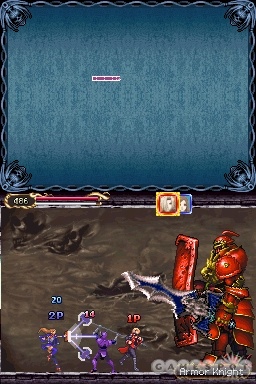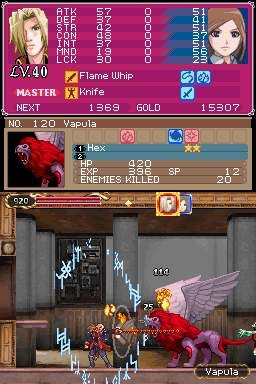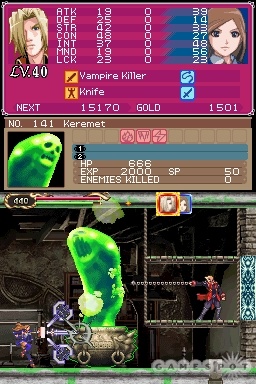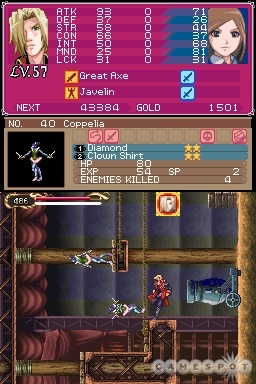Castlevania: Portrait of Ruin is the second game in the series to appear on the Nintendo DS, following up on Dawn of Sorrow. Whereas Dawn of Sorrow stuck very close to the Castlevania template and only added a few trivial touch-screen features, Portrait of Ruin instead forgoes the control gimmicks in favor of some interesting, though only slightly less trivial, gameplay tweaks. But despite the lack of any significant evolutionary progress, Portrait of Ruin is still a great action adventure game because it remains true to the hallmarks of the Castlevania series of games, with a consistently great style and level of detail; a lengthy quest with a large, interesting world to explore; and plenty of great enemies to battle, weapons to master, and secrets to discover. Portrait of Ruin isn't without flaws, but overall it's another great Castlevania game that shouldn't be missed.
Portrait of Ruin takes place in 1944, during the second World War. With the world in turmoil, there are a lot of tortured souls floating around and wailing, or whatever it is that souls do. All of this agony and despair make the world an appealing place for the old lord of darkness himself, Dracula. So Dracula's magic castle appears, and it's up to you to defeat the old bat and send him on his way. You take control of not one but two vampire hunters. Jonathan Morris is a distant relative of the Belmont family, who have played a major role in the previous Castlevania games. Jonathan wields a special whip known as the Vampire Killer, which he inherited from his father, who was also a vampire hunter. Jonathan is joined by his friend, a young female magic user named Charlotte Aulin. It's a complementary duo--Jonathan weakens evil beings with his trusty whip and Charlotte finishes them off with her powerful magic.
The game does require you to use the unique abilities of each character at times, but it's only absolutely essential in a handful of situations. So even though you have two characters, you'll probably end up using Jonathan about 90 percent of the time. You can switch characters at any time by pressing the X button, and you can also call your character using the A button to help you do battle, push an object, or stand on a switch. The game makes very little use of the DS touch screen, but you can touch the screen to direct your partner to a specific area when you summon him or her. When the other character is active, he or she will stay close to you and only attack when enemies come very close. You don't have to worry too much about your partner becoming a liability, because you can simply tell him or her to go away at any time. If your partner does take damage, you won't lose health but will lose magic power.
Each character has unique special skills that can often be quite useful. Jonathan can equip and use classic alternate weapons like throwing axes and daggers, as well as special melee moves and stances to enhance his offensive or defensive capabilities. Charlotte can equip magic spells such as fire, lightning, heal, monster summons, and so on. You can use your special skill by pressing up and Y, and if you want your partner to use his or her special ability, you just have to tap the R button. There are also combo attacks that inflict major damage and typically have a much wider area of effect than the standard or special attacks.
The partner mechanic works well, and it's remarkably easy and intuitive to control two characters at once. The only problem is that the game isn't always designed to take advantage of the team dynamic. You'll find a couple doors where one person has to stand on a switch while the other runs through, and some large blocks that require two people to push, but for the most part, you'll very rarely need to switch characters. Despite Charlotte being a powerful magic user, she only has a couple essential spells, and even those will likely remain unused for most of the game. Of course, if you want to control Charlotte instead of Jonathan, that's fine; she's quite capable of holding her own in combat when properly equipped.
Both characters gain experience as you fight enemies, and when you get enough experience you'll level up, which will increase your stats in parameters like strength, intelligence, attack, and defense. The enemies in the game always remain the same, so if you go back to an early part of the game after you've spent a significant amount of time leveling up your characters, you'll be able to wade through scores of enemies without any trouble at all. It does take a bit of the challenge out of the game, but it also provides an appreciable sense of progress as your characters get stronger.
Jonathan can equip a wide variety of weapons that you'll find throughout the game, including swords, maces, whips, and spears. There's even a special magic chain that homes in on enemy targets and has a very long range, making it one of the best weapons in the game. Charlotte can't equip weapons; instead, she'll equip magic books. Depending on the book she's using, Charlotte will conjure attacks. Using the Tome of Arms, for example, will cause an array of sharp weapons to stab out from her book as she attacks. In addition to the weapons, each character can equip armor, shoes, and head gear, as well as accessories such as rings. All of these items give essential boosts to your stats, meaning that it's usually worth your while to go out of your way to explore every nook and cranny of the castle or stage you're in.
You'll take your two characters through Dracula's castle, exploring corridors, breaking walls to reveal secret rooms, hopping on precarious platforms, breaking lighting fixtures, and killing all kinds of monsters. In true Castlevania style, you'll start out relatively weak, but you'll collect power-ups such as a double-jump that will permit you to access previously off-limits areas within the castle.

In Portrait of Ruin, you aren't confined to the castle. Instead, the castle is more like a central hub from which you enter cursed paintings that take you to other areas. There are four paintings in all if you just go for the quick ending, but if you stop there you'll miss out on a good third of the game or more, and you'll likely be pretty disappointed. If you go for the true ending, you'll access four more paintings, which are just slightly rearranged versions of the first four paintings, with tougher enemies and new bosses. The paintings all have themes, such as the Sandy Grave, which is a desertlike stage, and Nation of Fools, which is a twisted fun-house type of stage.
The stages all have their own enemies and bosses to contend with, although many enemies are prevalent throughout the entire game. The stages are all large and full of secret areas to explore and special items to collect, but the level design isn't quite as inspired as it has been in previous Castlevania games. There are a lot of plain hallways and vertically oriented rooms, but there's nothing especially interesting or exciting. Instead, it feels like a bunch of template pieces that have been connected in the simplest way possible to form one long, often-looping pathway. The levels are certainly still fun to explore, and you'll still get a great sense of satisfaction when you finally get to access a new area, but there are very few truly memorable areas in the world of Portrait of Ruin. Instead of remembering an area for its unique design or style, you'll remember it for the enemies that you fight there.
That's a good thing, because you'll fight some memorable enemies. The standard Castlevania creatures like the flying medusa heads, skeletons, and axe armors are all accounted for here, but the game really shines in its boss battles. Each boss has a few specific attack patterns that seem obvious but are never entirely easy to avoid. Even on your third or fourth try at defeating a boss, after you've memorized each and every attack pattern, you'll still have to be quick and nimble to emerge victorious. There are a few weak boss battles that you'll quickly forget, but the majority of them are very fun and quite challenging. Not only are they fun to fight, but the bosses just look darn cool, as well.
In fact, the whole game looks great. It still has the same-old 2D side-scrolling perspective that has been with the Castlevania series for almost 20 years now, but somehow Portrait of Ruin still puts a tremendous amount of style and detail into the characters, special effects, and environments in the game. All of the character animations are fluid and fun to watch, especially some of the unique and fairly elaborate animations of certain enemies you'll encounter. The character sprites are small but still convey plenty of emotion and are at least as detailed as any characters you'll find on the DS. The backgrounds are all nice to look at, as well, with different parts of the background scrolling independently to provide a sense of depth and scale. The only slight visual flaw you'll find in Portrait of Ruin is a bit of annoying slowdown that occurs during some of the larger boss battles when there's a lot going on at once. However, it's infrequent enough that it doesn't significantly interfere with the gameplay.
The sound and music are uniformly excellent in Portrait of Ruin. The music is all upbeat and enjoyable, with special themes for each area. It all matches the quality of previous Castlevania games, and you'll definitely want to play with the volume cranked up. The sound effects are very good, although they aren't particularly memorable because they are the same whipping and light-fixture-smashing noises you've been hearing for years. There's a decent amount of speech in the game, as well. Jonathan and Charlotte have quite a few lines, and the voices all sound great and lend a lot of personality to each character.
You can finish Portrait of Ruin in four or five hours on your first try, but that's only to get the basic ending. If you want to get the good ending--which is definitely worth it--you'll have to spend a good eight hours playing. Of course, with all of the items to collect and secrets to discover, you can easily spend twice that much time playing this game. Once you beat the game, you'll unlock secret characters and a couple alternate play modes. There's also a multiplayer component to the game. You can play via a local wireless connection or log on to Nintendo's Wi-Fi Connection service to play online. The only mode available in multiplayer is boss rush mode, which is a cooperative mode where you run from one end of a short level to the other as quickly as possible. Each level is filled with enemies and a couple bosses, but there's still not much to the mode and it won't keep you occupied for very long. You can also set up a store and connect to friends either locally or online to buy and sell items you've collected in the single-player game. However, item drops are extremely common in the game, and the vast majority of the items you collect aren't particularly useful, so there's little reason to go out of your way to buy items from other people.
Portrait of Ruin is another great installment in the long line of Castlevania games. It doesn't mess too much with the formula, but the changes it implements are good ones. It may be more of the same, but nevertheless Portrait of Ruin succeeds in rekindling old flames for Castlevania veterans and sparking new ones for people who are just looking for a great 2D action adventure game.


